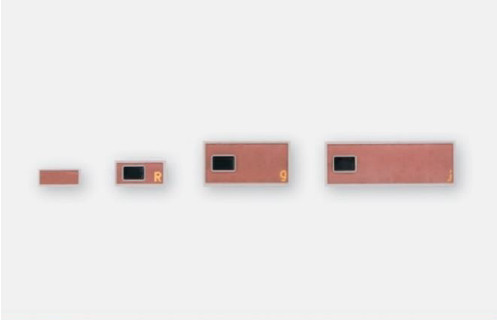KYOCERA designs and manufactures new ultra-small robust ceramic UHF RFID Tags for tool tracking in Aerospace industry
KYOCERA’s new ultra-high frequency RFID transponder is appliable to metal and – due to its robust ceramic package – suitable for reliable tool tracking within the aerospace industry.
- Semiconductor Components
Kyoto/London - Within the Aerospace industry, safety issues have special importance. In case of maintenance, repair and overhaul (MRO) services of aircrafts and spaceships, any object that is not where it is supposed to be provides a high risk to safety. These foreign objects include, among others, metal tools used for maintenance services by MRO service providers which are forgotten after servicing the aircraft. If metal tools are left behind in an aircraft after repair services, there exists a high risk of so-called ‘Foreign Object Damage (FOD)’. This describes damages caused by foreign objects that impair the quality, functionality, or economic value, of an aircraft. Estimations show that FOD costs within the aerospace industry amount to some billion Euro per year worldwide.

In order to avoid FOD, Kyocera’s robust ceramic UHF RFID tags are especially suited to identification and tracking of metal tools in the aerospace industry. RFID tags will be attached to workshop tools of MRO service providers in order to stay on the tool for its entire lifetime. The attached tag will withstand harsh environments which are typical for workshops, including impacts and dirt (e.g. oil, fuel, lubricants, etc.) without negative effects on the reading performance due to the robust ceramic package of the RFID tag. By using RFID tags, MRO providers are able to decrease the probability of forgetting tools in sensitive areas of an airplane. Apart from tracking metal workshop tools, it is also possible to trace aircraft components with RFID technology. The RFID tag will be attached to an aircraft component either during production or during repair services, which will stay afterwards on the tagged component. The tag will withstand the temperature differences which occur during flight operations. This way, it is possible to track the path of different aircraft components.
Additionally, RFID technology does not require line-of-sight scanning, in contrast to barcode labelling or direct marking technology. Due to the fact that no line-of-sight scanning of RFID is required, it is also possible to read RFID tags regardless of a tool’s condition (e.g. in case that the tool is covered by dirt, oil, etc.). Through RFID tagging, multiple tools will be identified through bulk reading at a time, so that tools do not have to be counted manually by mechanics. This provides the possibility of a more faster and more reliable tool check during MRO services. Airlines and MRO service providers can save time and costs by automatically identifying if all tools are stored safely in the workshop wagon or tool cabinet again. This can actively manage their security risk.
About Kyocera’s robust ceramic UHF RFID Tag
Kyocera Corporation offers small and robust UHF RFID tags consisting of ceramic packages with a proprietary multilayer structure, including a built-in RFID antenna that can increase the read range up to 2X as compared with conventional tags of the same size. In addition, Kyocera has successfully developed a new ultra-small tag with a size of 5 x 2 x 1.5 mm, meaning a further reduction in the tag volume of almost 50 % compared to the tag with a size of 3 x 6 x 1.7 mm. Kyocera offers four different sizes of the robust UHF RFID tag.
| Dimensions*1 | 5 x 2 x 1.5 mm |
6 x 3 x 1.7 mm |
10 x 5 x 1.7 mm |
15 x 5 x 1.7 mm |
|
|---|---|---|---|---|---|
| Read Range | 250 mW | 10 cm | 10 cm | 25 cm | 35 cm |
| 1 W | 40 cm | 60 cm | 120 cm | 180 cm | |
| IC type | Monza R6-P | Monza 4QT | Monza 4QT | Monza 4QT | |
| Connection | Flip-Chip | Wire-Bonding | Wire-Bonding | Wire-Bonding | |
| EPC memory | 128 bits | 128 bits | 128 bits | 128 bits | |
| User memory | 32 bits | 512 bits | 512 bits | 512 bits | |
| Note | Possible to use on metal | ||||
*1 Customized designs can be provided upon request for customer requirements
The new product offers a robust package made of Low Temperature Co-fired Ceramic (LTCC) with an embedded antenna that withstands high temperatures up to 300°C (depending on RFID tag structure) and humidity levels up to 85 %. Additionally, the ceramic package is designed with a special cavity structure to protect the IC chip against mechanical stress and chemical exposure.
Kyocera’s UHF RFID tags have a unique antenna design which differentiates itself from conventional tags; the proprietary multilayer structure of the antenna results in an increased read range in combination with a miniaturized ultra-small tag size. The RFID tags offer a superior reading distance in regard to their small size, so that a reading distance of 0.4 m can be achieved with a tag of the size of 5 x 2 x 1.5 mm (when applied on metal).
Kyocera RFID tags also offer advantages and customer-oriented solutions in other industries with similar requirements for identification and tracking of metal parts, including the metal industry and the oil and gas industry

right: Kyocera’s RFID tag attached on a wrench
For more information on KYOCERA: www.kyocera.eu

